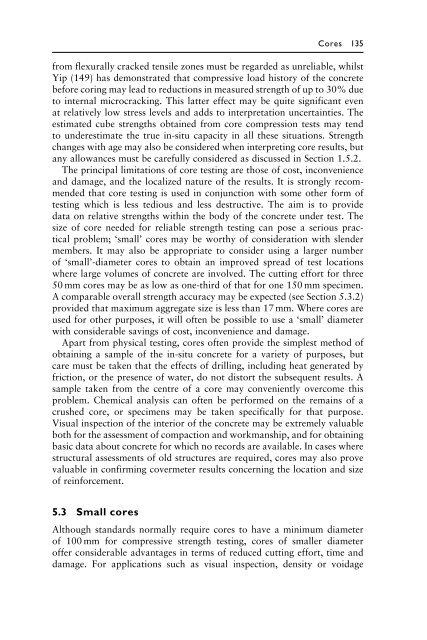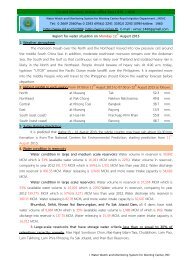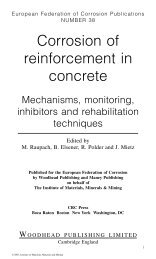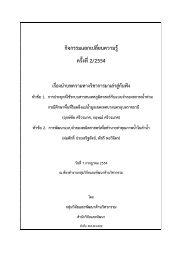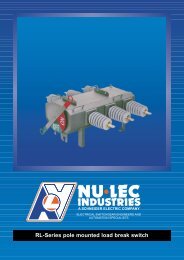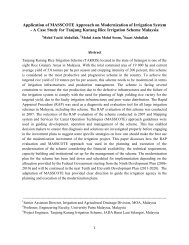Testing of Concrete in Structures: Fourth Edition
Testing of Concrete in Structures: Fourth Edition
Testing of Concrete in Structures: Fourth Edition
- No tags were found...
You also want an ePaper? Increase the reach of your titles
YUMPU automatically turns print PDFs into web optimized ePapers that Google loves.
Cores 135from flexurally cracked tensile zones must be regarded as unreliable, whilstYip (149) has demonstrated that compressive load history <strong>of</strong> the concretebefore cor<strong>in</strong>g may lead to reductions <strong>in</strong> measured strength <strong>of</strong> up to 30% dueto <strong>in</strong>ternal microcrack<strong>in</strong>g. This latter effect may be quite significant evenat relatively low stress levels and adds to <strong>in</strong>terpretation uncerta<strong>in</strong>ties. Theestimated cube strengths obta<strong>in</strong>ed from core compression tests may tendto underestimate the true <strong>in</strong>-situ capacity <strong>in</strong> all these situations. Strengthchanges with age may also be considered when <strong>in</strong>terpret<strong>in</strong>g core results, butany allowances must be carefully considered as discussed <strong>in</strong> Section 1.5.2.The pr<strong>in</strong>cipal limitations <strong>of</strong> core test<strong>in</strong>g are those <strong>of</strong> cost, <strong>in</strong>convenienceand damage, and the localized nature <strong>of</strong> the results. It is strongly recommendedthat core test<strong>in</strong>g is used <strong>in</strong> conjunction with some other form <strong>of</strong>test<strong>in</strong>g which is less tedious and less destructive. The aim is to providedata on relative strengths with<strong>in</strong> the body <strong>of</strong> the concrete under test. Thesize <strong>of</strong> core needed for reliable strength test<strong>in</strong>g can pose a serious practicalproblem; ‘small’ cores may be worthy <strong>of</strong> consideration with slendermembers. It may also be appropriate to consider us<strong>in</strong>g a larger number<strong>of</strong> ‘small’-diameter cores to obta<strong>in</strong> an improved spread <strong>of</strong> test locationswhere large volumes <strong>of</strong> concrete are <strong>in</strong>volved. The cutt<strong>in</strong>g effort for three50 mm cores may be as low as one-third <strong>of</strong> that for one 150 mm specimen.A comparable overall strength accuracy may be expected (see Section 5.3.2)provided that maximum aggregate size is less than 17 mm. Where cores areused for other purposes, it will <strong>of</strong>ten be possible to use a ‘small’ diameterwith considerable sav<strong>in</strong>gs <strong>of</strong> cost, <strong>in</strong>convenience and damage.Apart from physical test<strong>in</strong>g, cores <strong>of</strong>ten provide the simplest method <strong>of</strong>obta<strong>in</strong><strong>in</strong>g a sample <strong>of</strong> the <strong>in</strong>-situ concrete for a variety <strong>of</strong> purposes, butcare must be taken that the effects <strong>of</strong> drill<strong>in</strong>g, <strong>in</strong>clud<strong>in</strong>g heat generated byfriction, or the presence <strong>of</strong> water, do not distort the subsequent results. Asample taken from the centre <strong>of</strong> a core may conveniently overcome thisproblem. Chemical analysis can <strong>of</strong>ten be performed on the rema<strong>in</strong>s <strong>of</strong> acrushed core, or specimens may be taken specifically for that purpose.Visual <strong>in</strong>spection <strong>of</strong> the <strong>in</strong>terior <strong>of</strong> the concrete may be extremely valuableboth for the assessment <strong>of</strong> compaction and workmanship, and for obta<strong>in</strong><strong>in</strong>gbasic data about concrete for which no records are available. In cases wherestructural assessments <strong>of</strong> old structures are required, cores may also provevaluable <strong>in</strong> confirm<strong>in</strong>g covermeter results concern<strong>in</strong>g the location and size<strong>of</strong> re<strong>in</strong>forcement.5.3 Small coresAlthough standards normally require cores to have a m<strong>in</strong>imum diameter<strong>of</strong> 100 mm for compressive strength test<strong>in</strong>g, cores <strong>of</strong> smaller diameter<strong>of</strong>fer considerable advantages <strong>in</strong> terms <strong>of</strong> reduced cutt<strong>in</strong>g effort, time anddamage. For applications such as visual <strong>in</strong>spection, density or voidage


